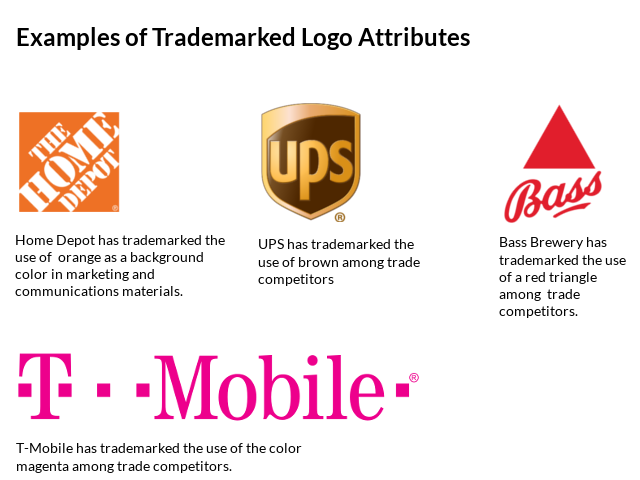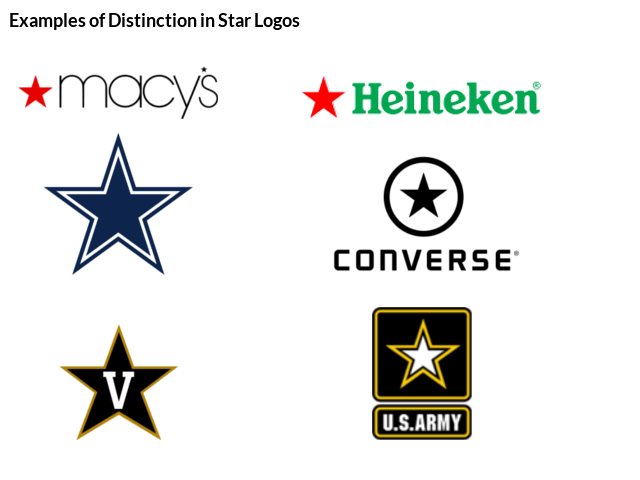Your logo is more than a piece of design; it is the visual representation of your brand and everything it stands for. It is the flag that your customers rally around, and it serves as the key distinguisher between your business and your competitors. In this article, we will explore why it’s essential to trademark your logo, the steps involved, and the role a trademark attorney can play in this process.
The Steps to Protecting Your Logo
1. Decide on Your Logo Concept
The first step to getting a logo trademark is-as you might expect-to create your logo. Your logo design can be a shape, symbol, images, words, or a combination thereof. The most important factor is ensuring that your logo is distinct.
You cannot simply pick a dictionary word that is connected to the product or service you are offering and use that as your logo. For instance, if you own a milk company, your logo cannot be “MILK” just by itself.
This is where working with a trademark attorney offers some benefit. An attorney can guide you through the design process to ensure that the logo is unique enough for trademark approval. At the same time, you can focus on creating a logo that aligns with your company’s vision. Once complete, your attorney can make sure the logo is in compliance with the United States Patent and Trademark Office (USPTO) directives.
2. Check for Existing Trademarks Before You Approve the Design
It’s pretty obvious that you shouldn’t rip off your competitors when you design a logo, but simply separating yourself from your obvious competitors might still land you in hot water. Before you approve the final design of your logo, you or your trademark attorney should search through the U.S. Patent and Trademark Office’s TESS system to see if any existing trademarked logos conflict with yours.
Companies protect their trademarks with a heavy hand. Even though your logo might be unique as a whole, it could contain shapes, symbols, or even colors that another company has trademarked.

Trademark owners will have the chance to oppose your trademark filing if they feel your logo infringes on any aspect of theirs. So why not simply file your trademark application and wait for any potential objections?
Logo designers cost money. The trademark application fee is at least $350, plus attorney fees if you retain one. If the U.S. Patent & Trademark Office (USPTO) upholds a trademark owner’s objection to your logo, you will need to pay again for each of these services. A trademark search can save you time, effort, and money.
3. Ensure a Design Distinctive Enough to Trademark
Companies and institutions often use a generic or archetypal symbol to represent their brand. Think about all of the stars, hearts, and paw prints you see in advertising material. Using these common symbols makes sense to many marketing executives – they’re universally understood and effective at characterizing a brand thanks to the cultural meanings we’ve attached to them. When you see a heart, you think love. When you see a tree, you think wilderness and nature. However, these symbolic logos are never as generic as they seem.
In order to receive approval from the USPTO, you must design a logo that possesses a distinctive character. In other words, there must be something unique about your logo that sets it apart from all the other stars, pine trees, light bulbs, etc. that exist as registered trademarks.
Some companies, such as Macy’s, add their word mark to a generic symbol. Others incorporate design twists that make generic symbols distinctive. Examples include the bite missing from the Apple logo. If you want to use a common symbol for your logo, then it must possess similarly distinctive characteristics.
Here are some examples that better illustrate what is acceptable when trademarking a universal or symbolic logo:

While each of these logos is based on a five-pointed star, they are all visually distinct; it is difficult to mistake one for the other. Even the Macy’s and Heineken logos, which both feature a red star preceding a word mark, are considered distinct because these companies work in different industries – retail and food and beverage, respectively. Therefore the trademarks can bear some resemblance to each other. Additionally, Heineken’s trademark features green lettering while Macy’s features a star as an apostrophe.
For an example of four entities using similar but distinctive logos in the same industry, take a look at these university paw print logos.

Each paw print is a registered trade mark of its respective university. While they are all visually similar, they manage to differentiate themselves through various means. Clemson’s and Penn State’s paw marks feature unique colors and notches in the bottom “pad” that help identify them as registered marks. The University of Missouri’s mark is visually similar to Clemson’s paw print, but is distinguished by its color scheme, its positioning, and the school’s block “M” logo on the bottom pad. The University of New Mexico’s paw mark is modeled after a wolf rather than a cat. It is therefore more slender than the other marks and distinguished by the use of claws and a grey border.
If you plan to use a common symbol for your company logo, it is crucial that you make it distinct like these businesses and institutions have done. Separate your brand from the competition by attaching a word mark, adding a design flourish, or using a unique color scheme to signify that your mark is your own. Doing so will strengthen your ownership of the mark and will also help protect you from trademark infringement in the future.
4. Apply for Your Trademark as Soon as Possible
Even if your product or service isn’t market-ready, you should still consider filing a trademark application. Why spend money to trademark something that doesn’t yet exist? Because doing so offers you a greater level of protection.
For the USPTO to approve a trademark application, the applying company must prove it currently uses the mark in commerce, or that it intends to use the mark in the near future. Filing an “intent to use” application helps ensure that the logo you just designed will be safe and totally protected before you roll out a full branding and marketing campaign. If you’re not utilizing a law firm or trademark attorney, you’ll need to consult the U.S. Acceptable Identification of Goods and Services Manual when writing the description for your logo.
Recommended reading – how long does the trademark application process take?
Once approved, you have six months to take one of two actions. If you begin using your logo in commerce within the six-month window, you must submit proof to the USPTO. Otherwise, you must file for an extension. Each extension application is subject to a fee.
To apply for an “intent to use” trademark you simply need to file a standard Trademark Application. There is a section where you can note that your application is based on bona fide or good faith intent to use in commerce. After the application is received, the government will issue you a Notice of Allowance. You then have six months (or longer if you pay for an extension) to put your trademark to use and to file a supplemental “Statement of Use” form.
Once that’s done, your trademark will be published to the official USPTO database.
5. Wait for the Trademark to be Approved
After you submit your application, a Trademark Examiner will review it. The examining attorney will then approve or reject your application. Trademark refusal happens for several different reasons. For example, the USPTO does not register marks that appear to carry the image of any deceased U.S. President whose spouse is still living. (Unless it is done with the consent of the spouse.)
Your mark may also be turned down if it is perceived to contain images or words that degrade national symbols. You will also have a hard time registering marks that can be viewed as scandalous or immoral. Your mark could also be declined if it is considered to be generic. The list goes on. Unfortunately, the USPTO does not award refunds for failed applications, so it is best to get it right from the start.
Once your logo is approved, the USPTO will give you the guidelines that you must follow to maintain your logo. It is also a good idea to set up a trademark watch service at this point. A watch service will be charged with preventing other businesses and organizations from using your logo illegally.
As these steps have shown, learning how to trademark a logo is fairly straightforward. With a good attention to detail and a good trademark attorney, any small business can protect its brand by registering its logo. Don’t let the process scare you. Once you have your trademark secured, the effort will be well worth it.
How We Can Work Together to Trademark Your Logo
If you don’t want to go through all the steps of trademarking a logo on your own, we’re here to help. Our lead attorney, Xavier Morales, has handled the filing of thousands of trademarks – more than 6,000 at last count. Put our experience to work for your business.
The Risks of Not Trademarking Your Logo
How important is it for a business owner to trademark their logo? Consider the case of Coca-Cola, one of the most visible brands in the world. Sold in over 200 countries, Coca-Cola is such a successful company that it can survive almost anything.
If you were to burn down half of its manufacturing plants, the company would still be able to rebuild and recoup. If Coca-Cola somehow ran into a severe cash drain, most banks would willingly issue out loans based on the company’s identity.
The one thing the company would struggle to recover from is the loss of its brand. If Coca-Cola lost its trademark registration for the brand, it would become just another nameless soft drink company in a sea of options. It’s likely that the company would begin to suffer shortly after that. Coca-Cola as a company might have an annual revenue of nearly $50 billion, but the brand-an intangible asset-is worth a lot more.
Your logo is your corporate identity. It is what distinguishes your business from others. So it makes perfect sense that you would want to trademark your logo. Unfortunately, far too many companies postpone the trademarking of their logo for different reasons, few of which are valid.
Should a company worry about trademark registration for its logo? That depends. Do you have big plans for your company? Do you want to protect your brand name and logo from being copied by competitors? Because if you do, you need to take steps towards securing the uniqueness of your brand and intellectual property from the get-go.
Your logo is the most powerful marketing weapon in a small business’s arsenal. It represents everything your brand stands for and wordlessly describes what it is exactly that your company does. It gives a face to your brand and provides your customers and partners with a flag to rally around. A good logo distinguishes you from your competition – and that’s exactly why you need to protect it.
Every day small businesses find themselves on the receiving end of a lawsuit because the logo they spent $15,000 designing infringes on someone else’s trademark or service mark. Worse, they might discover that one of their competitors has ripped off their logo and there’s little they can do about it, because they never took the proper legal steps to protect themselves. (This is one of the key dangers in trying to rely on a “common law” trademark.)
Don’t let this happen to you. When it comes time to create and trademark a logo for your company, make sure it passes legal muster before you sign on the dotted line.
Frequently Asked Questions
How much does it cost to trademark a logo?
The total cost to file a trademark with our assistance is $1,445. We charge a flat fee of $1,095, and there is a government filing fee of $350 (per class). You can read more about this in our article here.
Can I tramdeark a logo for free?
Well… kind of. As we explain in detail here, you can get “common law” trademark protection for free. However, there are definitely some risks and downsides to relying on this level of protection.
Does trademarking my logo and name give me rights to the corresponding domain name?
In many cases you might not have any claim at all to a top-level domain if you do not already own it. Your rights will vary depending on the specifics of the case, but unless someone registered the domain after you received your trademark registration, you might be out of luck. More in our full article here.
Which trademark symbol should I use once I have a federal trademark for my logo?
Check out our article here that explains the three trademark symbols.
Famous Logo Marks
The History of the Ford Logo History of The Subway Logo The History of the Google Logo History of the Seattle Seahawks Logo History of the Subaru Logo History of the Warner Brothers Logo History of the Yahoo Logo History of the Paramount Pictures Logo The History of the Cleveland Indians Logo The History of the Aunt Jemima Logo The History of the Pizza Hut Logo The History of the Pittsburgh Steelers Logo The History of the Toyota Logo The History of the AT&T Logo The History of the NBA Logo The History of the Chrysler Logo The History of the Denver Broncos Logo The History of the Chevy Logo The History of the YouTube Logo The History of the Golden State Warriors Logo The History of the Disney Logo The History of the LEGO Logo The History of the Coca-Cola Logo The History of the Nike Logo The History of the Fruit of the Loom Logo The History of the Burger King Logo The History of the Microsoft Logo The History of the Columbia Pictures Logo The History of the Amazon Logo The History of the NBC Logo The History of the McDonalds Logo The History of the NASA Logo The History of the Pepsi Logo The History of the Apple Logo The History of the Starbucks Logo

